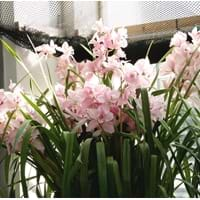Life Span
Annual and Perennial
Perennial
Type
Bulb or Corm or Tuber
Tender Perennial
Origin
Latin America and the Caribbean, Central America, Micronesia
Southeastern Asia, China, Japan
Types
Hannah Yams, Japanese Sweet Potatoes
Cymbidium madidum, Cymbidium suave
Habitat
Cold Regions, Tropical regions
Open Forest, Rainforest, Woodlands
USDA Hardiness Zone
11-12
8-15
Sunset Zone
21,22
H1, H2, 14, 15, 16, 17, 18, 19, 20, 21, 22, 23, 24
Habit
Vining/Climbing
Clump-Forming
Minimum Width
Not Available
Flower Color
Not Available
Not Available
Flower Color Modifier
Bicolor
Not Available
Fruit Color
Not Available
Not Available
Leaf Color in Spring
Green, Purple, Light Green, Chartreuse, Bronze
Not Available
Leaf Color in Summer
Light Green
Not Available
Leaf Color in Fall
Several shades of Green
Not Available
Leaf Color in Winter
Light Green
Not Available
Leaf Shape
Heart-shaped
Sword-like
Plant Season
Spring, Summer, Fall, Winter
Fall, Winter
Sunlight
Full Sun, Partial Sun
Partial Sun, Partial shade
Growth Rate
Very Fast
Medium
Type of Soil
Clay, Loam, Sand
Sand
The pH of Soil
Acidic, Neutral, Alkaline
Acidic, Neutral
Soil Drainage
Well drained
Well drained
Bloom Time
Late Fall, Early Winter, Winter
Not Available
Tolerances
Drought
Not Available
Where to Plant?
Ground, Pot
Ground, Pot
How to Plant?
Stem Cutting, Tuber propagation
Bulbs, Divison
Plant Maintenance
Medium
Medium
Watering Requirements
Average Water Needs, Needs a lot of water initially
Do not let dry out between waterings, Needs watering once a week
In Summer
Lots of watering
Lots of watering
In Spring
Moderate
Moderate
In Winter
Average Water
Average Water
Soil pH
Acidic, Neutral, Alkaline
Acidic, Neutral
Soil Type
Clay, Loam, Sand
Sand
Soil Drainage Capacity
Well drained
Well drained
Sun Exposure
Full Sun, Partial Sun
Partial Sun, Partial shade
Pruning
Remove damaged leaves, Remove dead branches, Remove dead leaves
Remove damaged leaves, Remove dead branches, Remove dead leaves
Fertilizers
All-Purpose Liquid Fertilizer
All-Purpose Liquid Fertilizer
Pests and Diseases
Aphids, Beetles, Leafminers, Red blotch
Red blotch
Plant Tolerance
Drought
Drought
Flower Petal Number
Single
Single
Foliage Texture
Coarse
Not Available
Foliage Sheen
Matte
Not Available
Self-Sowing
No
Not Available
Attracts
Aphids, Beetles, Mites, white worms
Bees
Allergy
Abdominal pain, Skin rash, Swelling, Vomiting
no allergic reactions
Aesthetic Uses
Not Used For Aesthetic Purpose
Cut Flowers, Landscape Designing, Showy Purposes
Beauty Benefits
Not Available
Not Available
Environmental Uses
Air purification
Air purification
Medicinal Uses
Potassium, ß-carotene, Vitamin C
Cancer, Eye Problems
Part of Plant Used
Leaves, Root, Shoots
Whole plant
Other Uses
Used As Food, Used for its medicinal properties
Air freshner, Employed in herbal medicine, Making Perfumes, Making Sweet Scented Oil, Oil is used for aromatherapy, Oil is used in perfume, soaps, creams, etc., Showy Purposes, Used As Food, Used as Ornamental plant, Used for fragrance
Used As Indoor Plant
Yes
Yes
Used As Outdoor Plant
Yes
Yes
Garden Design
Container, Edible, Groundcover, Hanging Basket, Herb / Vegetable, Mixed Border, Vine
Container, Cutflower, Hanging Basket, Houseplant, Rock Garden / Wall, Tropical
Botanical Name
IPOMOEA batatas
CYMBIDIUM
Common Name
Sweet Potato, Sweet Potato Vine
Cymbidium Orchid, Sword-leaf Cymbidium, boat orchid
In German
Süßkartoffel
Cymbidium Orchid
In French
Patate douce
Cymbidium Orchid
In Spanish
Batata
Cymbidium Orchid
In Greek
Γλυκοπατάτα
kymbes
In Portuguese
Batata doce
Cymbidium Orchid
In Polish
Słodki ziemniak
Cymbidium Orchid
In Latin
Dulcis SOLANUM TUBEROSUM
Cymbidium Orchid
Phylum
Magnoliophyta
Tracheobionta
Class
Magnoliopsida
Liliopsida
Order
Solanales
Orchidales
Family
Convolvulaceae
Orchidaceae
Clade
Angiosperms, Asterids, Eudicots
Angiosperms, Monocots
Tribe
Not Available
Cymbidieae
Subfamily
Not Available
Epidendroideae
Season and Care of Sweet Potato and Cymbidium Orchid
Season and care of Sweet Potato and Cymbidium Orchid is important to know. While considering everything about Sweet Potato and Cymbidium Orchid Care, growing season is an essential factor. Sweet Potato season is Spring, Summer, Fall and Winter and Cymbidium Orchid season is Spring, Summer, Fall and Winter. The type of soil for Sweet Potato is Clay, Loam, Sand and for Cymbidium Orchid is Sand while the PH of soil for Sweet Potato is Acidic, Neutral, Alkaline and for Cymbidium Orchid is Acidic, Neutral.
Sweet Potato and Cymbidium Orchid Physical Information
Sweet Potato and Cymbidium Orchid physical information is very important for comparison. Sweet Potato height is 60.00 cm and width Not Available whereas Cymbidium Orchid height is 30.00 cm and width 30.00 cm. The color specification of Sweet Potato and Cymbidium Orchid are as follows:
Sweet Potato flower color: Not Available
Sweet Potato leaf color: Green, Purple, Light Green, Chartreuse and Bronze
Cymbidium Orchid flower color: Not Available
- Cymbidium Orchid leaf color: Not Available
Care of Sweet Potato and Cymbidium Orchid
Care of Sweet Potato and Cymbidium Orchid include pruning, fertilizers, watering etc. Sweet Potato pruning is done Remove damaged leaves, Remove dead branches and Remove dead leaves and Cymbidium Orchid pruning is done Remove damaged leaves, Remove dead branches and Remove dead leaves. In summer Sweet Potato needs Lots of watering and in winter, it needs Average Water. Whereas, in summer Cymbidium Orchid needs Lots of watering and in winter, it needs Average Water.





